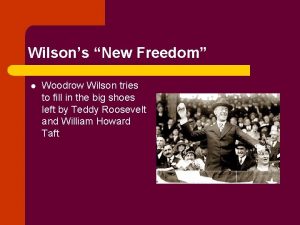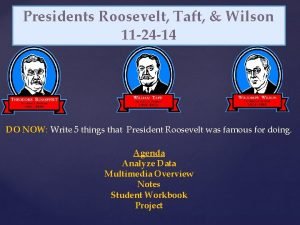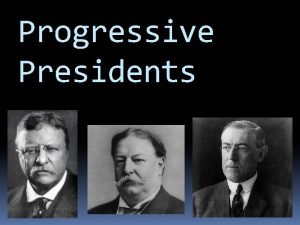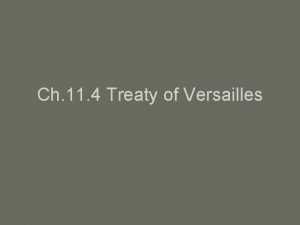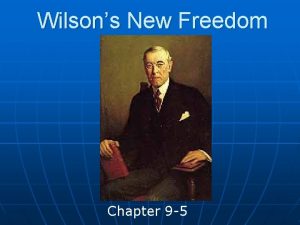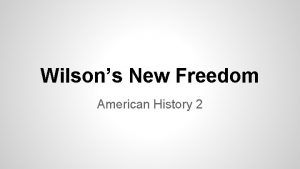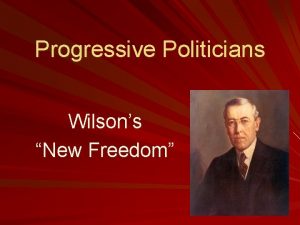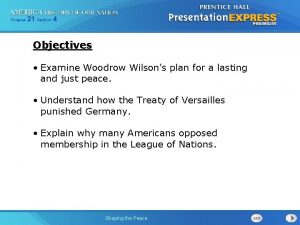WILSONS NEW FREEDOM Chapter 6 Lesson 3 Woodrow










- Slides: 10

WILSON’S NEW FREEDOM Chapter 6 Lesson 3

Woodrow Wilson New Freedom: Woodrow Wilson’s program to place government controls on corporations in order to benefit small businesses. “The man with only a little capital is finding it harder and harder to get into the field, more and more impossible to compete with the big fellow. Why? Because the laws of this country do not prevent the strong from crushing the weak. ” – W. Wilson attacked the “triple wall of privilege”: Blocked businesses from being free. � � � Tariffs Banks Trusts

Regulations under Woodrow Triple Wall of Privalege: Underwood Tariff Act (1913): Cut tariffs so that if American companies’ prices were too high, consumers could buy foreign goods. � Tariffs � � Banks Federal Reserve Act (1913): Law that placed national banks under the control of a Federal Reserve Board, which runs 12 regional banks that : � � � Trusts � hold the reserve funds from commercial banks set interest rates supervises commercial banks. ***Still in place today. Federal Trade Commission (FTC): Government agency established in 1914 to identify : � � � 16 th Amendment: 1913 constitutional amendment that gave Congress the authority to levy an income tax. The 16 th amendment more than made up for the $ the government lost by lowering tariffs on imports. Graduated Income Tax – wealthy pay a higher % of income than poor do monopolistic business practices false advertising dishonest labeling. Clayton Antitrust Act (1914):

The Struggle Against Discrimination Progressivism Presents Contradictions � � The Limits of Progressivis m Most Progressives were white Anglo-Saxon Protestant reformers who were indifferent or actively hostile to minorities. Americanization: Reformers believed that assimilating immigrants into American society would make them more loyal and moral citizens. Dress like white middle class Replace foods/customs of their homeland with Protestant practices and values. Prejudice against immigrants was one of the forces behind the temperance movement. � � Many believed that drinking customs of the “old world” corrupted the “new world” & would lead to moral decline Part of the reason for the 18 th amendment

The Struggle Against Discrimination � African Americans Demand Reform � Niagara Movement: Denounced the idea of gradual progress. (Leading African American Thinkers) � � � Booker T. Washington: Told blacks to move slowly toward racial progress. W. E. B. Du Bois and William Monroe Trotter: Both urged African Americans to demand immediately all the rights guaranteed by the Constitution. Springfield, Illinois: Mob of whites tries to lynch two black men. (Lincolns Home) Gains white reformers attention. Niagara Movement and white reformers join forces. National Association for the Advancement of Colored People (NAACP): Interracial organization founded in 1909 to abolish segregation and discrimination and to achieve political and civil rights for African Americans Urban League: Network of churches and clubs that set up employment agencies and relief efforts to help African Americans get settled and find work in the cities

Legacy of Progressivism What was the legacy of the progressive movement? In your notes, describe three different reforms enacted by the Progressives and explain the lasting impact these reforms have had on the US.

Legacy of Progressivism The federal government grew to offer more protection to Americans’ private lives while at the same time gaining more control over peoples’ lives. Following the flurry of worker-protection legislation in 1916, the progressive movement lost momentum as the nation’s attention turned from reform to war. The movement’s drive clearly waned with the coming of World War I.

Legacy of Progressivism The initiative, referendum, recall, the 17 th and the 19 th Amendments expanded voters’ influence. The federal government grew to offer more protection to Americans’ private lives while at the same time gaining more control over peoples’ lives. Expanded the government’s role in managing natural resources: � Dams � National Parks � Resource Use

Progressive Era Legislation Major Constitutional Amendments � 16 th � 17 th � 18 th � 19 th Other Major Legislation � Sherman Antitrust Act � Elkins Act Hepburn Act Meat Inspection Act Pure Food & Drug Act Federal Reserve Act Clayton Antitrust Act National Reclamation Act � � � Democratic Reforms � Initiative � Referendum � Recall *The initiative, referendum, recall, the 17 th and the 19 th Amendments expanded voters’ influence.

Progressive Era Movements (within Progressivism) � � Social Gospel Settlement House Suffrage Temperance Reformers � � � � Muckrakers (Sinclair, Steffens, Riis, Tarbell) Jane Addams Florence Kelley Carrie Chapman Catt Ida B. Wells Booker T. Washington W. E. B. Du. Bois John Muir Reform Groups � NCL � NAWSA � Niagara Movement � NAACP � Anti-Defamation League Presidents � Theodore Roosevelt � William Howard Taft � Woodrow Wilson
